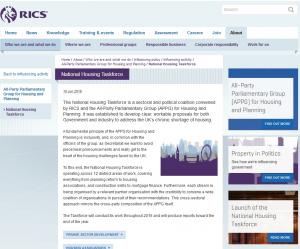



The Empty Homes Network has drafted its submissions to the National Housing Taskforce, which is an initiative of the All-Party Parliamentary Group for Housing and Planning. The submissions are now available for comment by our members.[1]
The Taskforce was set up in June of this year, following the establishment of the APPG in July 2015. The scope of the Taskforce's programme is immense, involving 12 separate workstreams, one of which is entitled 'Improving and Releasing Existing Stock'. The brief overview of that workstream on the RICS website reads
Forum discussion on commercial conversion submission
Library Item for clusters of empties submission
Library item for commercial conversion submission
Lead organiser: Empty Homes
Official figures suggest there are over 200,000 long-term empty homes, almost enough to fulfil our housing supply requirements for an entire year. Whilst building more new homes is essential to meet the scale of the housing challenge, bringing existing empty homes back into use can clearly make a significant contribution.
This work-stream is assessing how this can be achieved across three key themes: areas of high concentrations of empty homes; the "buy-to-leave" problem and the potential for putting commercial properties to residential use.
There was a round-table discussion, chaired by Lord Richard Best, for each of the three issues, with RICS providing the secretariat at each event. Representatives from EHN attended the meetings on clusters of empties and conversions; others attending to give evidence were also members of the Network.
The Network - which rather typically was not invited to contribute its views on what the key themes might be - made the point that a more strategic approach to empty homes was needed, and that two of the 3 issues selected were of little relevance in most parts of the country; indeed, the issue of high-value buy-to-leave issue has little relevance even across most of London and we have declined to comment on it. We were encouraged to submit our more strategic concerns under the "clusters of empties" theme.
In both of our submissions we have emphasised that sustainable empty homes initiatives that have broad aims are needed to provide a platform for addressing more specific issues. Otherwise, the fear is that someone's pet plan with minimal applicability will displace serious thinking about what is likely to be most beneficial for effective empty homes work. The Kent 'No Use Empty' initiative was a particularly useful examplar to refer to, partly because of its low cost-per-unit of homes created or returned to use - which makes it readily easy to replicate - partly because of the amount of evidence for what works that it has accumulated over its ten-year life; and above all for the fact that relied on its generic loans scheme as the essential tool for enabling conversions. It is not often appreciated, too, that Kent (or more specifically the Isle of Thanet) received the third-highest allocation for Clusters of Empties funding in the country. It is doubtful whether it would have been able to mount such an effective bid without the platform of No Use Empty available.
Similarly, we highlighted the fact that many of the Community Grants Programme recipients had been responsible for conversion projects using the generic EHCGP grant from DCLG, which we said should be re-instituted.
In promoting the value of the community-led housing sector - which we always happy to do - we also had to sound a note of caution about its capacity and made a plea for research and pilot schemes into how it might be expanded and, in particular, extended into new geographical areas.
NOTES
[1] The drafts are available in our discussion forum, where members can comment, or as MS Word documents for download from our Library:
Forum discussion on clusters of empties submissionForum discussion on commercial conversion submission
Library Item for clusters of empties submission
Library item for commercial conversion submission
